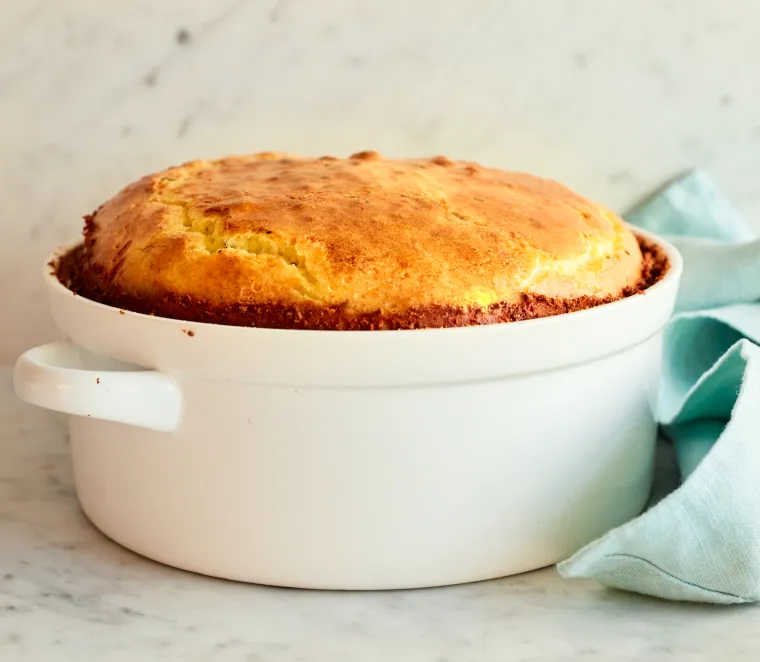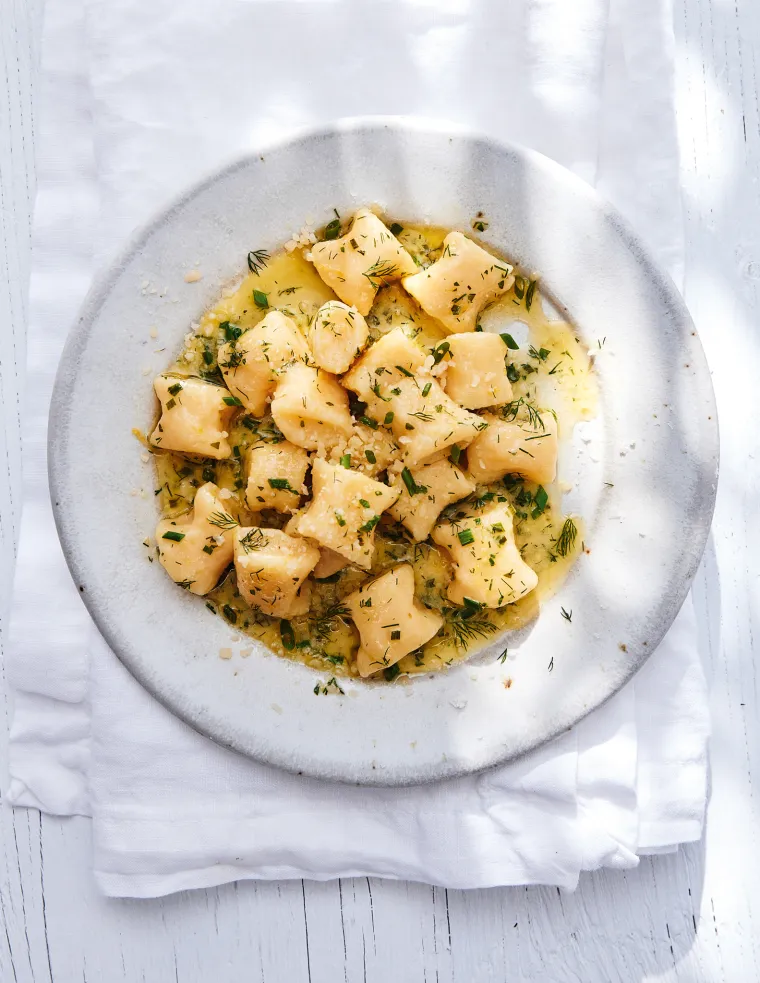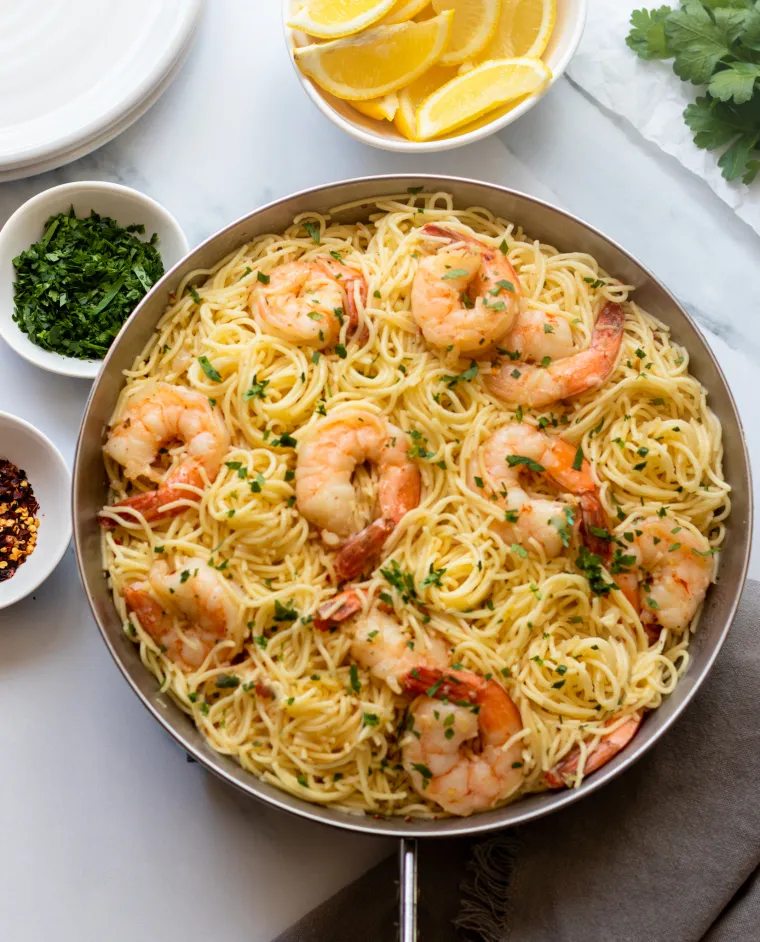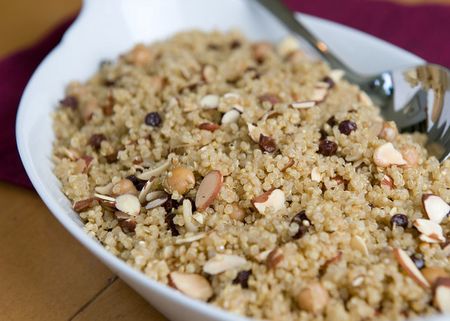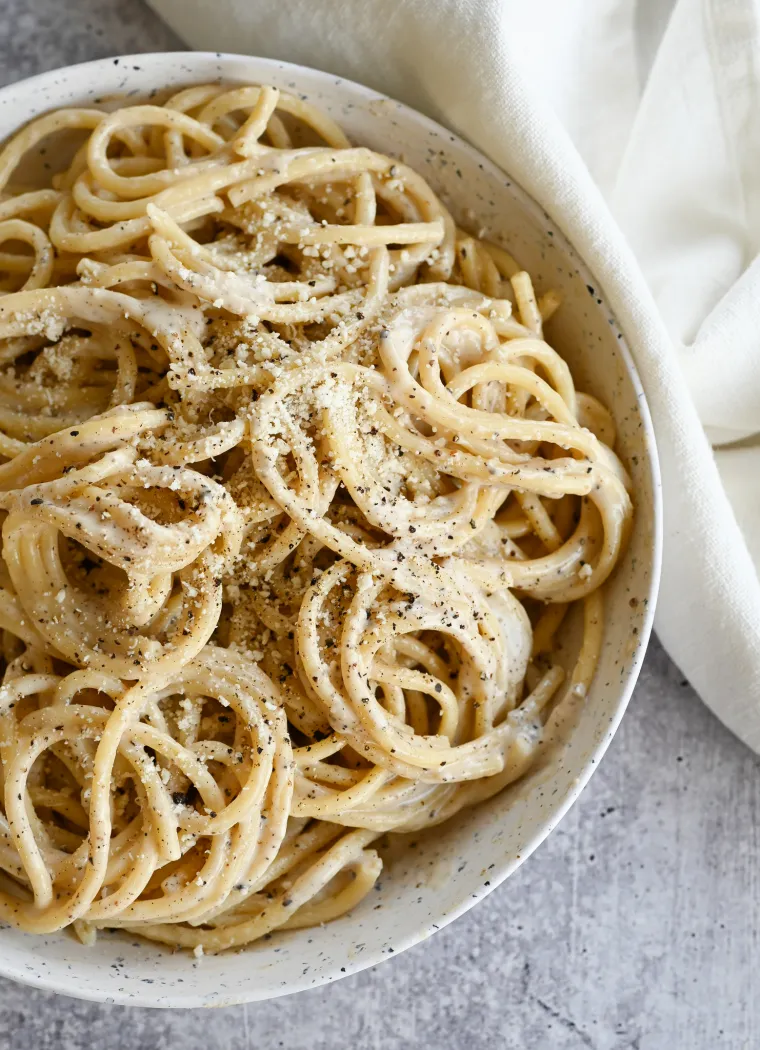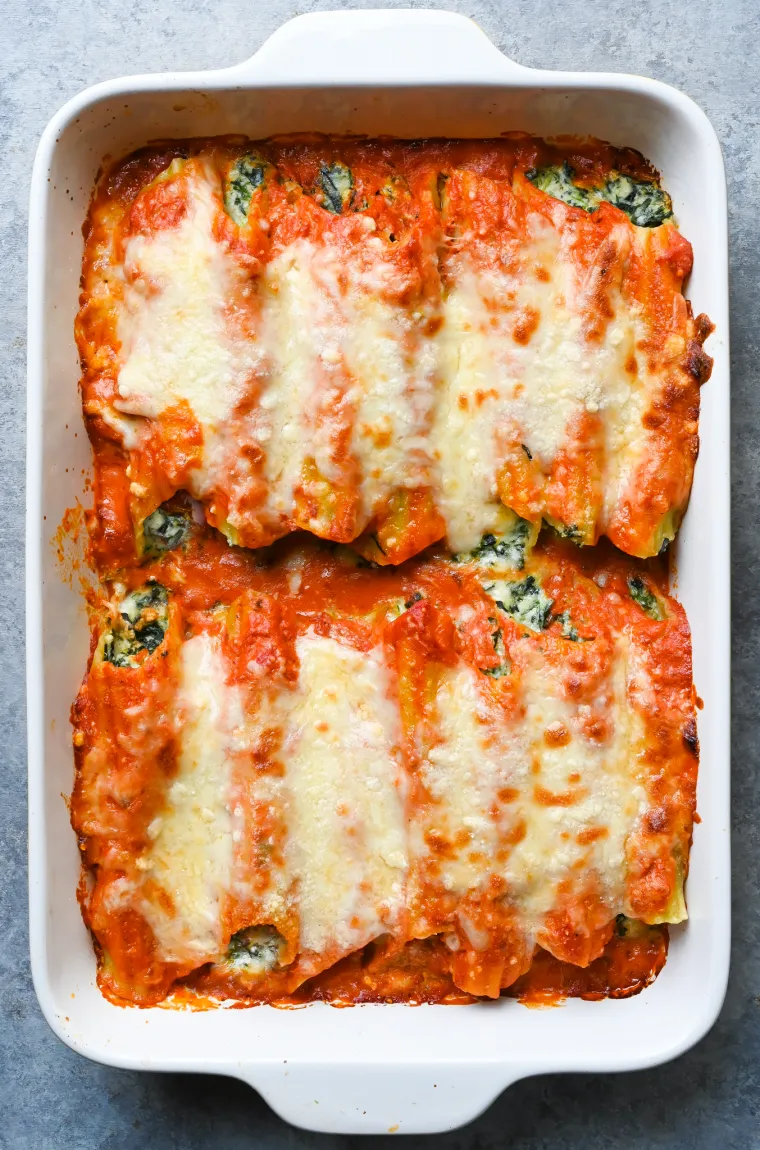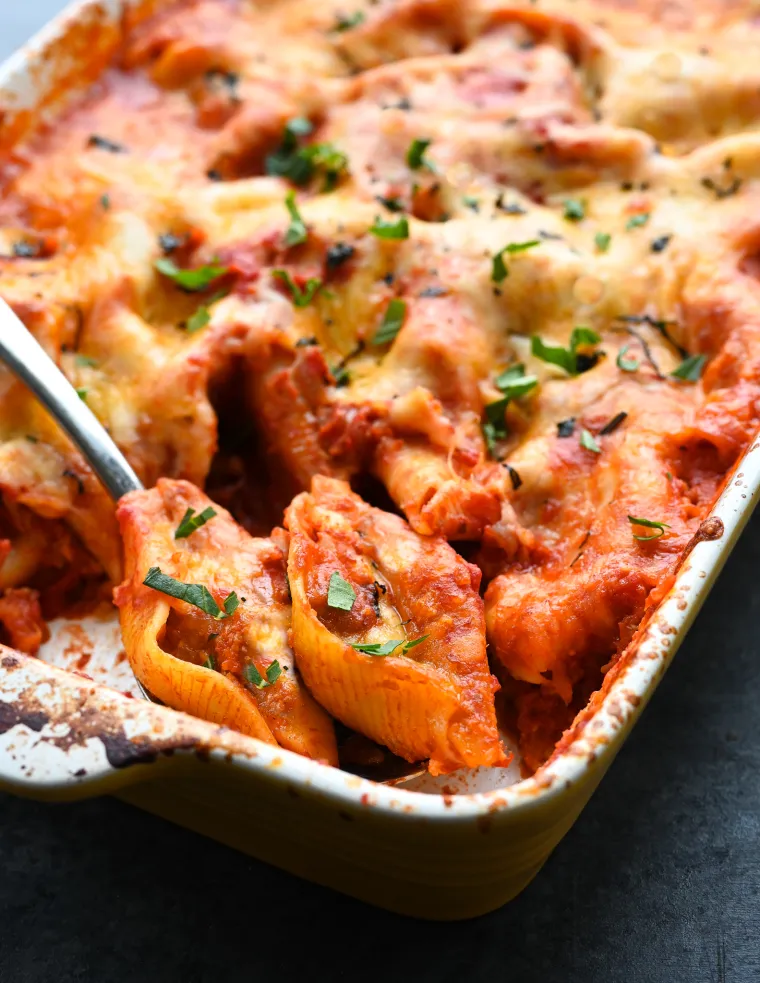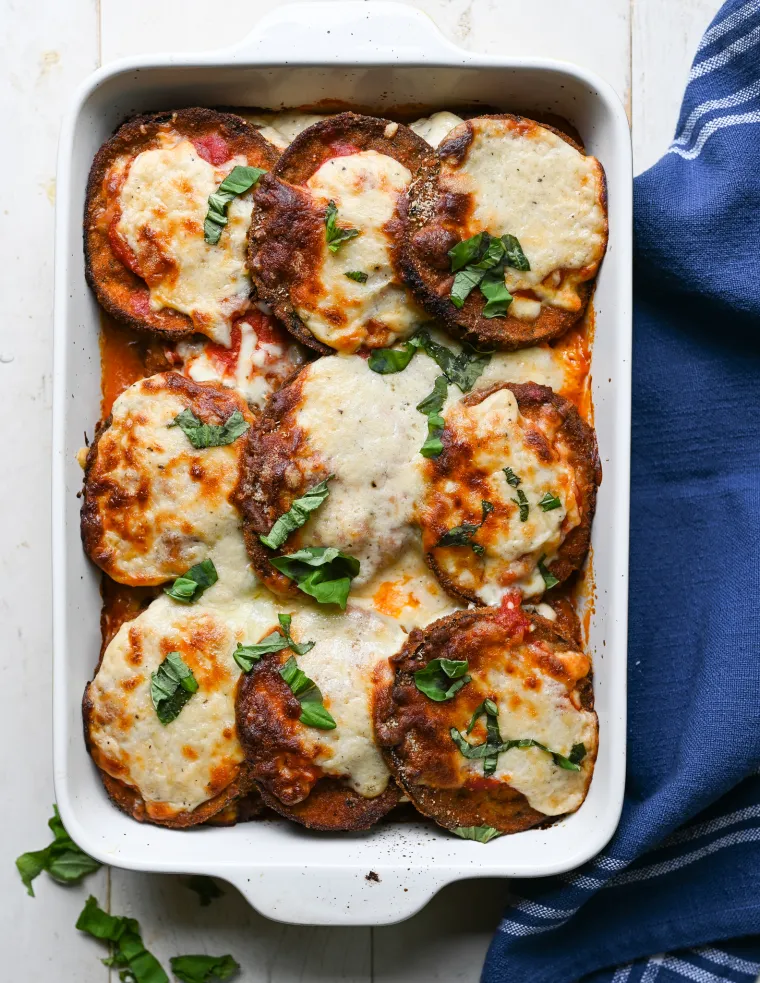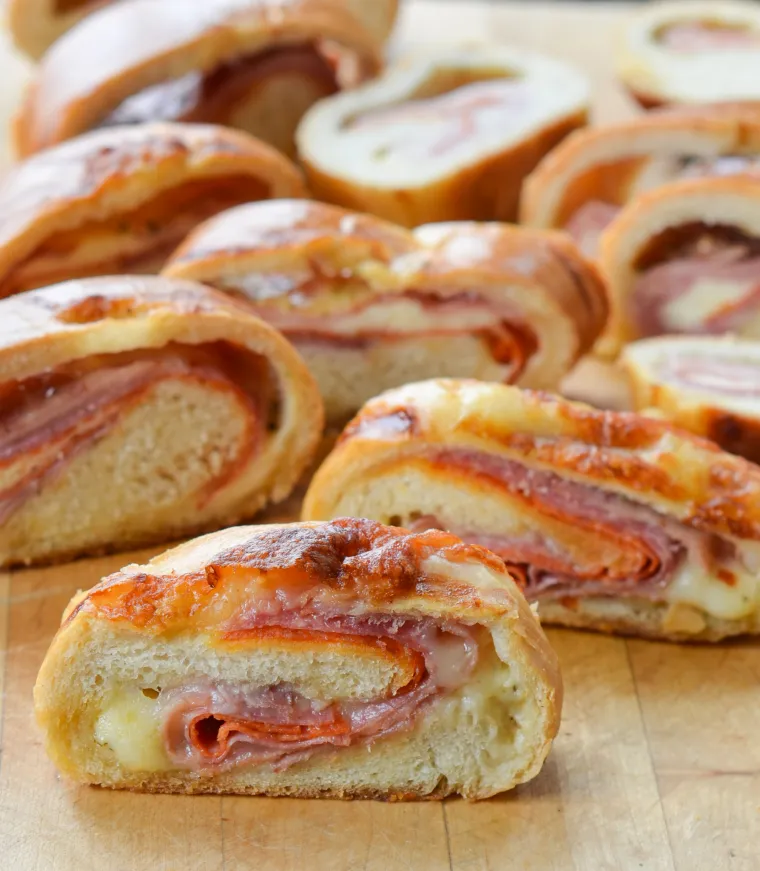Articles contributed by the community, curated for your enjoyment and reading.
Filters
Reset
When I was an apprentice at L’Auberge Chez François, a charming French restaurant right outside of Washington, DC, one of my jobs was prepping the soufflé dishes for the evening service. It was tedious because there were so many of them. Soufflés are always popular menu items because they have a reputation for being temperamental — heaven forbid you peek into the oven or make a loud noise! — and even confident cooks are nervous to make them at home. But the truth is that soufflés are quite easy to make. I think one thing that makes soufflés feel intimidating is the need for a special soufflé dish, but you don’t need one here; a 2-quart glass or straight-sided ceramic baking dish — even an 8-inch square Pyrex pan — will work. Pair the soufflé with a salad for a light and elegant meal that will wow your family (they don’t need to know how easy it is!).
What You’ll Need To Make A Cheese Soufflé
Step-by-Step Instructions
Preheat the oven to 350°F and set an oven rack in the middle position. Use softened butter to grease a 2-quart soufflé or ceramic casserole dish. Add ¼ cup of the Parmigiano-Reggiano and roll it around the dish to coat the bottom and sides.
Pro Tip: Dessert soufflés are made in dishes coated with butter and sugar. Savory soufflés are made in dishes coated with butter and finely grated cheese. A thorough coating prevents the soufflé mixture from sticking and helps it climb its way up the sides; it also forms a delicious crust.
In a small saucepan over medium heat, melt the 3 tablespoons of butter.
Add the flour and cook, whisking constantly, for about 1 minute.
Add the milk and whisk the mixture until smooth.
Continue cooking, whisking constantly, until the mixture thickens and comes to a boil, a few minutes (be sure to scrape the edges of the pan with your whisk, where the mixture thickens first). Remove the pan from the heat and stir in the salt, pepper, and nutmeg.
Add the Cheddar and the remaining ¼ cup Parmigiano-Reggiano.
Stir until the cheeses are melted and the mixture is thick and smooth.
Let the mixture cool for 10 minutes, then add the egg yolks and the chives.
Whisk to combine.
In the bowl of an electric mixer fitted with the whisk or beaters, whip the egg whites and cream of tartar on medium-low speed until foamy, about 1 minute. Increase the speed to medium-high and whip until stiff peaks form, about 3 minutes.
Add one-third of the milk/cheese mixture to the whites.
Beat on medium speed until smooth.
Add the remaining milk mixture to the whites and, using a rubber spatula, fold until the mixture is uniform.
Pro Tip: Folding is a technique used to mix a light and airy ingredient, like beaten egg whites, into a heavier mixture, like a soufflé base, without deflating the lighter mixture. After combining the two mixtures, use a rubber spatula to cut down to the bottom of the bowl. Pull the spatula toward you, scooping up the contents from the bottom of the bowl, and in one sweeping motion, fold the scooped up portion over the top. Turn the bowl a quarter turn and repeat the motions, scraping the sides of the bowl occasionally, until the ingredients are evenly combined.
Pour the mixture into the prepared soufflé or casserole dish (it should come about 1 inch from the top; if you have extra batter, discard or bake it in a separate dish).
Place on a baking sheet and slide into the oven. (The baking sheet just makes it easier to move in and out of the oven.) Bake for about 35 minutes, or until puffed and golden brown on top. The soufflé will stay inflated for a while, but it is best to serve it immediately.
Please find original recipe here.
This seriously delicious and oh-so-easy ricotta gnocchi recipe is just one gem among many in Catherine McCord’s new cookbook, Meal Prep Magic: Time-Saving Tips for Stress-Free Cooking. Packed with wholesome, easy-to-follow recipes the whole family will love, this book will change the way you think about preparing meals—say goodbye to mealtime stress, hello to being more organized, and enjoy more quality time with loved ones. As someone who’s admittedly right-brained and organizationally-challenged, I found this book to be both inspiring and incredibly practical. And that color-coded refrigerator on the cover? Now, that’s some serious fridge goals!
Ricotta Gnocchi
Unlike the more commonly known potato gnocchi, ricotta gnocchi is quick and easy to make and requires no special equipment. Potato gnocchi is made from boiled, riced potatoes combined with flour and egg. This dough is then rolled into ropes, cut into bite-sized pieces, and pressed with a fork to create ridges that can catch sauce. It has a soft and somewhat chewy texture, with a mild flavor that works well with a wide variety of sauces.
Ricotta gnocchi substitutes ricotta cheese for the potatoes, resulting in a lighter, creamier texture. The preparation process is similar to potato gnocchi, but it’s much simpler to make — no need to cook, peel or rice potatoes! However, keep in mind that the moisture content of the ricotta can make the dough a bit tricky to handle. It’s important to use a good quality, well-drained ricotta to avoid overly wet dough (I use the widely available Galbani brand).
Please find original article here.
Succulent shrimp bathed in a garlicky, white wine and lemon-infused butter sauce — shrimp scampi makes an excellent sauce for pasta. However, in many recipes, the pasta is more of an afterthought, left in need of more flavor and sauce. In this version, both the pasta and the shrimp share the spotlight equally. While you could certainly use any long pasta — think spaghetti, linguine, or fettuccine — my preference is for angel hair or capellini. The thin, delicate strands have a knack for soaking up the garlicky sauce, packing maximum flavor into every bite. Speaking of garlic, the recipe demands a generous six cloves, so if your garlic press has been gathering dust, now’s the time to break it out and put it to work! Making shrimp scampi with pasta is fairly simple, but it’s important to watch the shrimp’s cooking time. If you cook them for too long, they can become rubbery. The trick is to take them off the heat as soon as they turn opaque and pink.
What You’ll Need To Make Shrimp Scampi with Pasta
Pro Tip: When a recipe calls for wine, select a bottle that is inexpensive but still good enough to drink. If you don’t want to open a large bottle, look for mini bottles that are sold in four-packs and contain about ¾ cup (160ml) of wine per bottle; they are ideal for cooking. Always avoid “cooking wines,” as they contain salt and other additives.
Step-by-Step Instructions
Bring a large pot of salted water to a boil. Add the pasta and cook to al dente according to the package instructions.
Reserve 1 cup of the cooking water, then drain.
Pro Tip: Most pasta recipes suggest reserving some of the pasta water before draining. This cooking water serves an important purpose. When pasta is cooking, it releases some of its starch, and that starchy, salty water makes a great thickener for sauces. If you’re concerned you may forget to save the cooking water, put a measuring cup in your colander. That way, when you go to drain the pasta, you’ll have that visual reminder.
Meanwhile, heat the oil in a large skillet over medium heat. Add the shallots and cook, stirring frequently, for about 1 minute.
Stir in the garlic, red pepper flakes, and ¼ teaspoon each salt and pepper.
Add the shrimp and cook, stirring occasionally, until they are pink and just cooked through, about 3 minutes.
Transfer the shrimp to a plate.
Add the wine to the skillet and simmer until reduced by half, 3 to 4 minutes.
Add the butter, lemon juice, and lemon zest, ½ cup of the reserved cooking water, and ½ teaspoon salt. Stir until the butter is melted.
Add the drained pasta and continue to cook, tossing, until the pasta is warmed through, adding more of the reserved cooking water as needed if the pasta seems dry. Return the shrimp and any juices from the plate to the skillet and toss with the pasta.
Stir in the parsley, then taste and adjust seasoning, if necessary. Serve with lemon wedges.
Please find original recipe here.
Leery of health foods with names you can’t pronounce? Me too, which is why it took me so long to discover quinoa (pronounced keen-wah), otherwise known as the “Supergrain of the Future.”
What you’ll need to make quinoa pilaf with chickpeas, currants, and almonds
Here I’ve taken a page from the aromatic couscous dishes of North Africa, flavoring it with onions, garlic, chicken broth, and spices, then adding currants, chickpeas, and toasted almonds. It’s a terrific accompaniment to any simply prepared entrée…and it’s just as good cold for lunch or a picnic.
If you’re at all hesitant about using curry powder or cumin, not to worry…the flavors here are very mild and work well together. The currants and honey complement the spices with a touch of delicious sweetness, and the chickpeas and almonds add protein and crunch.
Give it a try. My husband loves it, and he has no idea how good it is for him.
Please find original recipe link here.
One of the simplest pasta dishes in existence, cacio e pepe is a Roman dish that translates to “cheese and pepper” (it’s pronounced kaa-chee-ow-ee-peh-pay). It is traditionally made from just three ingredients – coarsely grated black pepper, finely grated Pecorino Romano cheese, and pasta – but many versions also call for a bit of olive oil, butter, or cream. The magic happens when some of the starchy, salty pasta cooking water is added to these basic ingredients to make a rich, creamy sauce. Think of it as an uncomplicated, peppery Italian mac and cheese. This version is adapted from That Noodle Life: Soulful, Savory, Spicy, Slurpy, a deliciously fun new cookbook by Mike and Stephanie Le from iamafoodblog. The recipe feeds two since it’s the perfect no-food-in-the-house dinner or late-night snack to throw together on a whim, but it can easily be doubled.
The original recipe in the book is made using the traditional method of slowly adding the cheese and pasta water to the cooked noodles, stirring constantly to emulsify the sauce. This technique takes practice, as the cheese tends to clump up and stick to the pan if it gets too hot. To ensure a creamy sauce, I borrow a trick from Italian chef Luciano Monosilio and blitz the pasta water and cheese in a blender before adding it to the pasta. You still have to be careful not to overheat the sauce, but not nearly as much so.
What You’ll Need To Make Cacio e Pepe
Pasta: The recipe calls for either bucatini (also known as perciatelli) or spaghetti. Bucatini resembles spaghetti but is slightly thicker and has a small hole that runs through the center, so it is essentially hollow spaghetti (buco actually translates to “hole”). Bucatini is ideal for soaking up the sauce, but spaghetti is a great alternative if you can’t find it.
Cheese: Pecorino Romano is a salty, sharp-flavored cheese made from sheep’s milk. It can be found in most supermarkets near the Parmigiano-Reggiano. While the two cheeses are sometimes interchangeable in recipes, I recommend sticking with the Pecorino Romano here, as it has a bolder flavor.
Pepper: Make sure to use freshly ground black pepper – it’s significantly more flavorful than pre-ground pepper – and set your grinder to the coarsest setting. As for the amount, I’ve given a range depending on how peppery you like your pasta.
Butter: While not a traditional ingredient in cacio e pepe, the butter is used to “bloom” the fresh ground pepper before mixing it in with the pasta. It also makes for a creamier sauce without diluting the other flavors.
Step-by-Step Instructions
In a Dutch oven or large pot, bring 2 quarts of water and 1 teaspoon of salt to a boil. Add the pasta and cook according to package instructions until al dente.
Reserve 1 cup of the pasta cooking water and drain.
Set the same pot over low heat and melt the butter. Add the pepper.
Cook, stirring constantly, until fragrant, about 1 minute.
Add the drained pasta to the pot and toss to coat evenly. Remove the pot from the heat.
In a blender, combine the cheese and ⅔ cup of the pasta cooking water.
Blend until smooth and creamy, 10 to 15 seconds.
Add the sauce to the pasta in the pot and toss with tongs.
Place the pot back over low heat and cook, stirring constantly with the tongs, until the sauce is the consistency of a thin cream sauce, a few minutes. Add more of the reserved pasta water to thin the sauce only if necessary. Be careful at this stage: if the sauce gets too hot, it will start to clump up and stick to the pot and tongs.
Once the sauce is the right consistency, immediately transfer the pasta to bowls and serve. Pass more cheese and pepper at the table, if desired.
Please find original recipe link here.
I love Anne Burrell’s recipes, and this pasta dish, adapted from her cookbook Cook Like a Rock Star: 125 Recipes, Lessons, and Culinary Secrets (Clarkson Potter, 2011), is one of my favorites. It’s a creamy twist on pesto pasta, and it’s super quick to make — you can have it on the table in 25 minutes, tops. While the pasta cooks, you whip up a pesto with toasted walnuts, peppery arugula, sharp cheese, and garlic. When the pasta is ready, you toss it with the pesto, a bit of cream, and some of the pasta cooking water for a lusciously rich and flavorful dish.
What You’ll Need To Make Linguine with Creamy Arugula Walnut Pesto
Step-By-Step Instructions
Bring a large pot of salted water to a boil. Add the linguine and cook according to package instructions until al dente.
Meanwhile, place the walnuts on the prepared baking sheet and bake for 6 to 7 minutes, or until fragrant.
In a food processor, combine the toasted walnuts, arugula, garlic, pecorino Romano, Parmigiano Reggiano, salt, and pepper.
Process until the mixture resembles a coarse paste.
While the machine is running, drizzle in the olive oil through the feed tube until the mixture is mostly smooth.
Reserve about 1½ cups of the pasta cooking water, then drain the linguine in a colander.
Combine the pesto, cream, 1/2 cup of the cooking water, and drained linguine in a large saucepan.
Toss over medium heat until the pasta is evenly coated with the sauce and warmed through. Add more pasta water as necessary to thin the sauce.
Serve immediately and enjoy!
Please find original recipe here.
Looking for an easy way to elevate your traditional spinach manicotti recipe? I have a wonderful recipe that incorporates a few shortcuts and cooking tricks that take this classic dish to the next level without any extra work for you. First, I add heavy cream to good-quality jarred marinara sauce, creating a rich tomato sauce that pairs perfectly with the cheesy spinach filling. It’s as easy as opening a jar and a carton! Next, I add creamy mascarpone, mozzarella, and sharp Pecorino Romano cheeses to the traditional ricotta and spinach filling. This not only adds delicious flavor but also prevents the filling from becoming grainy, which is a common issue with pasta dishes made with ricotta cheese.
Fun fact: the word “manicotti” means “little sleeve” in Italian, describing the cylindrical shape of the pasta tubes. It’s a great prep-ahead dish to pop in the oven when you’ve got company coming or simply for enjoying with family. Pair it with a salad and some crusty bread for a cozy and satisfying meal.
What You’ll Need To Make Spinach Manicotti
Step-by-Step Instructions
Step 1: Parboil the Manicotti Shells
Bring a large pot of salted water to a boil. Cook the manicotti shells for exactly 6 minutes (they will only be partially cooked).
Drain well and rinse with cold water.
Add the ricotta, mascarpone cheese, 1 cup of the mozzarella, 1 cup of the Pecorino Romano, the spinach, basil, garlic, oregano, and salt.
Mix until evenly combined.
Transfer the filling to a pastry bag or large zip-lock bag. (If using a zip-lock bag, be sure the corners are square; the rounded-corner bags are difficult to use.) Twist and squeeze the bag so the filling is in one corner. With scissors, snip a ¾-inch opening in corner. Pipe the filling into both ends of the manicotti shells, filling until completely full.
Step 3: Make the Sauce
In a large bowl, combine the marinara sauce and heavy cream.
Mix to combine.
Transfer the filling to a pastry bag or large zip-lock bag. (If using a zip-lock bag, be sure the corners are square; the rounded-corner bags are difficult to use.) Twist and squeeze the bag so the filling is in one corner. With scissors, snip a ¾-inch opening in corner. Pipe the filling into both ends of the manicotti shells, filling until completely full.
Step 3: Make the Sauce
In a large bowl, combine the marinara sauce and heavy cream.
Mix to combine.
Step 4: Assemble & Bake
Spread ¾ cup of the sauce into a 9×13-inch baking dish.
Arrange the stuffed manicotti shells, narrow side up, over the sauce.
Pour just enough sauce to cover the manicotti (you’ll have about ¾ cup leftover; save it for serving).
Cover the dish tightly with aluminum foil. Bake for 35 minutes. Uncover and top the manicotti with the remaining 1 cup mozzarella and ¼ cup Pecorino Romano cheeses.
Bake, uncovered, for 10 to 15 minutes more, until the cheese is melted and lightly golden. (To brown the cheese further, turn on the broiler and bake for a few more minutes, keeping a close eye, until the cheese is golden.)
Let sit for about 10 minutes before serving.
Please find original recipe here.
When I think of classic Italian stuffed shells, I think of cozy Sunday night dinners around the table with family. This recipe, adapted from Big Flavors from Italian America by America’s Test Kitchen, fits that bill perfectly. The recipe is fairly simple to make because there’s no need to parboil the shells before stuffing them. Instead, the shells are smothered in a thin tomato sauce prior to baking, ensuring the pasta cooks through. The filling is loaded with flavor, thanks to a blend of creamy ricotta, gooey fontina, and salty Pecorino Romano cheeses, as well as garlic, basil, and oregano. Finally, to make the dish even more irresistible, a generous sprinkle of fontina cheese over the shells creates a rich, cheesy topping. Even without any meat, this dish is as satisfying as the heartiest lasagna.
To stuff the shells, disposable pastry bags come in handy (and you can use them for decorating cakes and cookies or filling deviled eggs, too). However, if you don’t have them, a ziplock bag with a snipped corner does the job well.
What You’ll Need To Make Stuffed Shells
Step-by-Step Instructions
Step 1: Make the Sauce
Heat the oil in a large saucepan over medium heat until shimmering. Add the onion, salt, and pepper.
Cook, stirring occasionally, until softened and lightly browned, about 10 minutes. Stir in the garlic and red pepper flakes and cook until fragrant, about 30 seconds (don’t brown the garlic).
Stir in the crushed tomatoes, water, and sugar and bring to a gentle boil. Reduce the heat to medium-low and cook, uncovered, until flavors have melded, about 5 minutes. (The cooled sauce can be refrigerated for up to 3 days.)
Step 2: Make the Filling
Combine the ricotta cheese, shredded fontina (or whole-milk mozzarella) cheese, Pecorino Romano cheese, eggs, basil, cornstarch, garlic, oregano, and salt in a bowl.
Mix until thoroughly combined.
Transfer the filling to pastry bag or large zipper-lock bag. (If using a zipper-lock bag, be sure the corners are square; the rounded-corner bags are difficult to use.)
Step 3: Stuff and Bake the Shells
Adjust the oven rack to middle position and preheat the oven to 400°F. Place the shells open side up on the counter. Cut ½-inch off of the tip or corner of the bag.
Pipe the filling into shells until each is full.
Spread 1 cup of the sauce over the bottom of 9×13-inch baking dish. Transfer the shells, open side up, to the prepared dish.
Pour the remaining sauce evenly over the shells to completely cover.
Cover the dish tightly with aluminum foil. Bake until the shells are tender and the sauce is boiling rapidly, about 45 minutes. Remove the dish from the oven and discard the foil.
Sprinkle the fontina (or mozzarella) over top. Return to the oven and bake, uncovered, until the cheese is lightly browned, about 15 minutes.
Let the dish cool, uncovered, for 15 to 20 minutes (this rest is essential to fully cook the pasta).
Sprinkle with the basil and serve.
Please find original link here.
Eggplant Parmesan is a comforting layered casserole similar to lasagna, only with breaded and fried slices of eggplant replacing the noodles. The eggplant is shingled and layered in a baking dish with marinara sauce, mozzarella cheese, béchamel sauce, and Parmigiano Reggiano and then baked until bubbly and golden. The traditional preparation takes some time – particularly salting, breading, and frying the eggplant slices – but you can save time by using good-quality jarred marinara sauce. It’s very important to salt the eggplant for at least 90 minutes before frying – this not only seasons the eggplant from the inside out but also draws out the liquid so it absorbs less oil and gives it a creamy, silky texture.
You may be wondering if you can bake the eggplant instead of frying it. It will work if you use enough oil on the baking sheets, but I strongly recommend sticking with the traditional frying method, as it will give you the best result in terms of both flavor and texture. I serve eggplant parmesan as a main dish with a Caesar or green salad, but it can also be served as a side dish to meatballs, grilled steak, or Italian sausage.
What You’ll Need To Make Eggplant Parmesan
Step-by-Step Instructions
Step 1: Salt the Eggplant
In a large bowl, on a baking sheet, or directly on a cutting board, sprinkle 1 teaspoon of salt evenly all over the eggplant slices.
Lay out a few layers of paper towels on a large cutting board or baking sheet. Arrange about one-third of the eggplant slices in a single layer and cover with more paper towels. Continue stacking the eggplant and paper towels, finishing with a final layer of paper towels. Let sit for 1½ to 2 hours. Press on the paper towels to absorb any excess liquid before proceeding.
Step 2: Make the Béchamel Sauce
Béchamel sauce is not necessarily traditional in eggplant parmesan, but I love the richness it adds. It counters the acidity of the marinara sauce and also prevents the melted mozzarella cheese from turning rubbery.
Melt the butter in a small saucepan over medium heat, then add the flour.
Cook, whisking constantly, for 2 minutes.
Add the milk and whisk until evenly combined.
Bring to a boil, then reduce the heat to medium-low and simmer, whisking constantly, for 2 minutes, until the mixture thickens. Add the Parmigiano Reggiano, salt, and pepper.
Whisk to combine and set aside.
tep 3: Bread and Fry the Eggplant
Combine the flour and ¾ teaspoon salt on a large plate. Whisk the eggs with 2 tablespoons cold water in a wide bowl. Mix the breadcrumbs with ¾ teaspoon salt on a large plate.
Lightly coat each slice of eggplant in the flour, shaking off excess.
Dip in egg mixture, letting any excess drip off.
Then dredge in the breadcrumbs, pressing with your fingertips so the crumbs adhere. (Use one hand for the dry ingredients – the flour and breadcrumbs – and one for the egg mixture – it’s much neater this way!) Set the breaded eggplant slices on a baking sheet.
ine another baking sheet with a few layers of paper towels. Pour enough oil into a large (12-inch) skillet to measure about ¼-inch deep and heat over medium heat until hot (if you dip a piece of eggplant into the oil, it will sizzle immediately). Working in batches, add as much eggplant as will fit in a single layer.
Fry, flipping once, until golden brown, about 3 minutes per side.
Transfer to the paper towel-lined baking sheet. Repeat, frying the remaining eggplant and layering it between sheets of paper towels to drain.
Step 4: Assemble and Bake
Preheat the oven to 425°F and set an oven rack in the middle position.
Spread ¾ cup of the marinara sauce over the bottom of a 9×13-inch baking dish.
Layer in one-third of the eggplant slices, overlapping the slices to fit.
Cover the eggplant with another ¾ cup of marinara sauce.
Sprinkle with 1 cup of the mozzarella cheese, then spoon one-third of the béchamel sauce over the cheese (if the béchamel has solidified a bit, it’s fine to add it in dollops; no need to spread it around).
Repeat two more layers, leaving the edges of the eggplant exposed on the top layer to create crispy edges. Sprinkle with the Parmigiano Reggiano.
Bake until bubbling and golden brown, 30 to 35 minutes. Cool, loosely covered with foil, for about 20 minutes, then scatter the basil over top (if using), cut into slices, and serve.
Make-Ahead/Freezer-Friendly Instructions
Eggplant parmesan can be assembled up to 2 days before baking; it can also be frozen, baked, or unbaked, for up to 3 months. (If freezing, defrost in the refrigerator overnight prior to reheating/baking.)
Please find original recipe here.
An Italian-American dish that originated in the city of Philadelphia, stromboli is like a rolled-up version of pizza. Filled with cheese and Italian deli meats, like pepperoni, salami, and ham, and served with marinara sauce for dipping, it’s a huge crowd-pleaser – perfect for game day, an easy dinner, or anytime you’re having people over. Just keep in mind that stromboli disappears quickly; I recommend making two rolls, especially if you’re feeding men and boys.
I use my favorite homemade pizza dough to make stromboli, pizza, and calzones but store-bought dough works very well, too. Don’t worry if your stromboli bursts a little while baking; it’s normal for some cheese to ooze out of the crust. In fact, some say that the name for this dish was taken from Mt. Stromboli, one of the three active volcanos in Italy because the ingredients look like they are about to explode from a volcano.
What You’ll Need To Make Stromboli
Step-by-Step Instructions
On a lightly floured work surface, stretch and/or roll the dough into a 10×12-inch rectangle, about 1/4-inch thick.
Arrange the dough rectangle so the long side is closest to you. Brush the surface with the oil, leaving a 1-inch border around the edges. Spread the garlic evenly over the top of the oil, then sprinkle with the oregano, a pinch of red pepper flakes (if using), and the pecorino romano.
Shingle the provolone slices evenly over the pecorino romano, followed by the ham, mozzarella, and cured meats.
Brush the borders of the dough with the egg (reserve the remaining egg for brushing the top of the stromboli). Fold the bottom third of the stromboli in toward the middle.
Fold the top third of stromboli down to cover first fold, creating a wide log, like a folded letter. Pinch the seam tightly to seal.
Transfer the stromboli to the prepared baking sheet, seam side down. Pinch the ends tightly to seal and tuck underneath. Loosely cover the stromboli with plastic wrap and let rise at room temperature for 1 hour. (The stromboli won’t look much different after the rise; that’s okay.)
Preheat the oven to 375°F and set an oven rack in the middle position. Brush the top of the dough with the remaining egg. Using a sharp knife, make 5 evenly spaced 1/2-inch-deep slits, 1-1/2 inches long, on top of the stromboli.
Bake until golden brown, puffy, and bubbling, about 35 minutes (if you have a thermometer, the center should register 200°F). Some grease or cheese may bubble out of the sides and top; that’s normal. Use a paper towel to blot any excess grease on the baking sheet.
Let the stromboli cool on the baking sheet for 15 to 20 minutes, then transfer to a cutting board and cut into 1-inch-thick slices. Serve warm or at room temperature, with marinara sauce on the side (if using).
Please find original recipe here.
